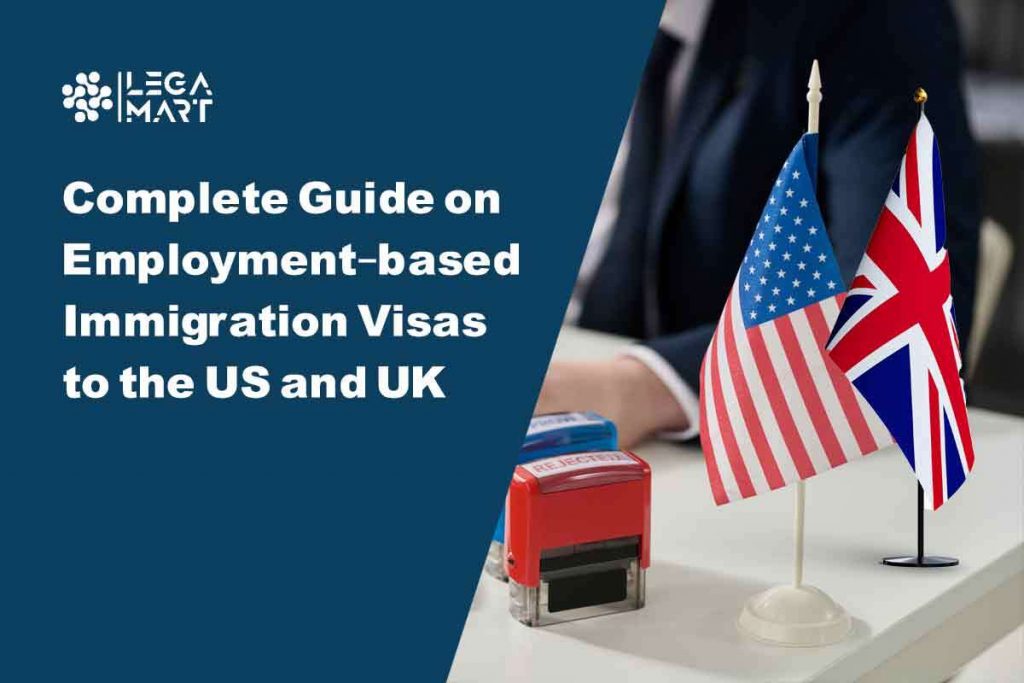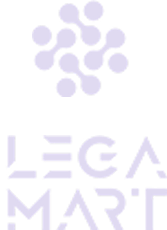- Introduction
- Purpose of the guide: Employment-based immigration visas to the US and UK
- Part 1: Complete guide on Employment-based immigration visas to the US
- Tips for preparing a strong visa application and supporting documents
- Final Thoughts and Recommendations
- Frequently Asked Questions (FAQs)
- Part 2: Complete guide on Employment-based immigration visas to the UK
Introduction
Employment-based immigration visas are a crucial aspect of immigration law that enables foreign workers to enter and work in a foreign country based on a job offer from a sponsoring employer. These visas provide a pathway for individuals with specialized skills, education, and experience to immigrate to a new country, where they can use their abilities to contribute to the local economy and society.
This type of immigration visa is designed to address the shortage of skilled workers in specific industries and to fill the gap between the demand for labor and the available pool of workers. The process of obtaining an employment-based immigration visa can be complex, involving multiple steps and various requirements, but for those who are successful, it can lead to a new life in a new country, with the potential for growth and advancement.
Purpose of the guide: Employment-based immigration visas to the US and UK
This guide provides comprehensive information on employment-based immigration visas, including eligibility requirements, application procedures, and the different types of visas available. The guide aims to serve as a resource for individuals seeking employment in a foreign country and for employers sponsoring foreign workers. It will provide practical advice and tips to help individuals prepare for the visa application process and make informed decisions.
Part 1: Complete guide on Employment-based immigration visas to the US
Eligibility requirements
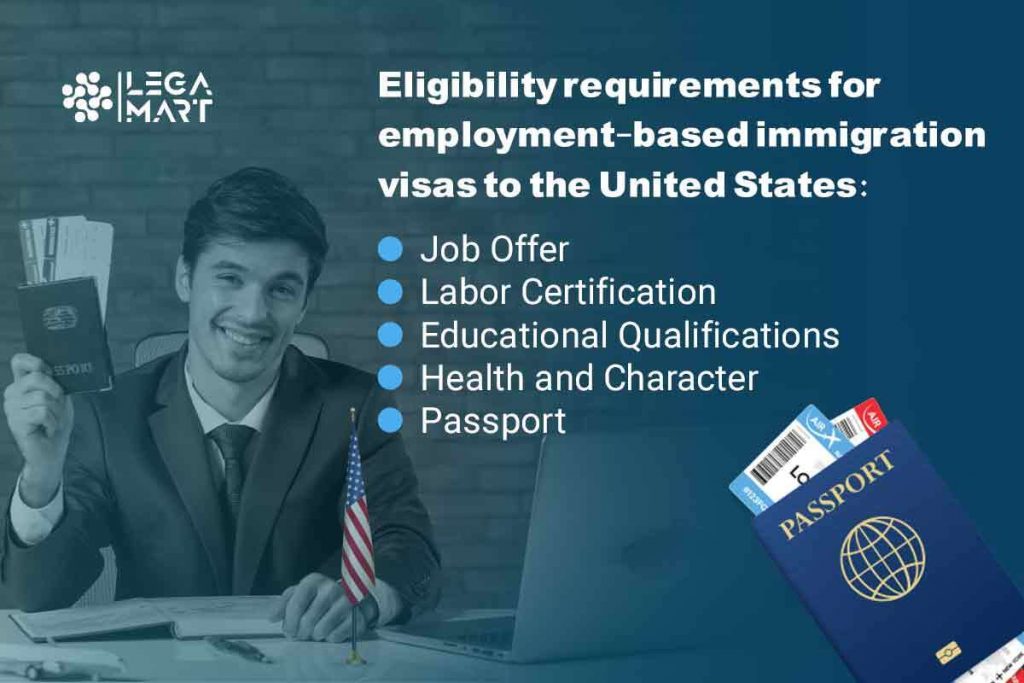
Eligibility requirements for employment-based immigration visas to the United States vary depending on the specific type of visa being sought. However, some general eligibility criteria apply to all employment-based visas. These include:
- Job Offer: An individual must have a job offer from a US employer who is willing to sponsor their visa application. The employer must provide evidence that the individual is qualified for the offered position and that a US worker cannot fill the position.
- Labor Certification: The US employer must obtain a labor certification from the Department of Labor, which confirms that there are no qualified US workers available for the offered position.
- Educational Qualifications: An individual must have the education and experience required for the offered position, as determined by the US Department of Labor.
- Health and Character: An individual must be in good health and of good moral character, as determined by a medical examination and background check.
- Passport: An individual must have a valid passport and be able to travel to the United States.
In addition to these general eligibility requirements, specific visas may have additional requirements. For example, some visas require an individual to have exceptional skills or to be an investor in a US business. Therefore, it is important to research the specific requirements for the type of visa being sought.
Overall, eligibility for an employment-based immigration visa to the United States is based on a combination of factors, including the individual’s job offer, qualifications, health, and character. It is important to carefully research and understand the specific requirements for each type of visa in order to increase the chances of a successful application.
Labor Certification
Overview of the Labor Certification Process
The labor certification process is critical in obtaining an employment-based immigration visa to the United States. The process involves obtaining a certification from the US Department of Labor (DOL), which confirms that no qualified US workers are available for the offered position.
The labor certification process begins with the US employer applying with the DOL, demonstrating that they have made a good faith effort to recruit US workers for the offered position and that no qualified US workers were found. The DOL will review the application and determine whether to grant the labor certification.
The labor certification process is designed to protect US workers by ensuring that they are given priority for job opportunities and that foreign workers are only employed in situations where no qualified US workers are available.
Role of the US Department of Labor
The US Department of Labor plays a critical role in the labor certification process. The DOL is responsible for reviewing and approving labor certification applications filed by US employers. The DOL will evaluate the employer’s recruitment efforts, the qualifications of the offered position, and the qualifications of the foreign worker being sponsored.
If the DOL determines that the labor certification application meets all requirements, the DOL will issue the labor certification, which will be required to be submitted as part of the individual’s immigration visa application. If the DOL determines that the labor certification application does not meet all requirements, the DOL will deny the application, and the individual will not be eligible for an employment-based immigration visa.
The DOL is committed to ensuring that US workers are prioritised for job opportunities and that foreign workers are only employed in situations where no qualified US workers are available. As such, the DOL takes its role in the labor certification process very seriously and will only grant certifications in cases where it is satisfied that all requirements have been met.
Form I-140 Immigrant Petition
Overview of the Form I-140
The Form I-140, Immigrant Petition for Alien Worker, is a key document used in the employment-based immigration process in the United States. The form is filed by US employers on behalf of foreign workers who they wish to sponsor for permanent residency in the United States.
Form I-140 serves as a petition to the United States Citizenship and Immigration Services (USCIS) to classify the foreign worker as an immigrant in a specific employment-based category. The form must be accompanied by the required supporting documentation, including a labor certification from the US Department of Labor.
Form I-140 is an important step in the employment-based immigration process, as it determines the eligibility of the foreign worker for an immigrant visa or adjustment of status.
Steps to Filing the Form I-140 with USCIS
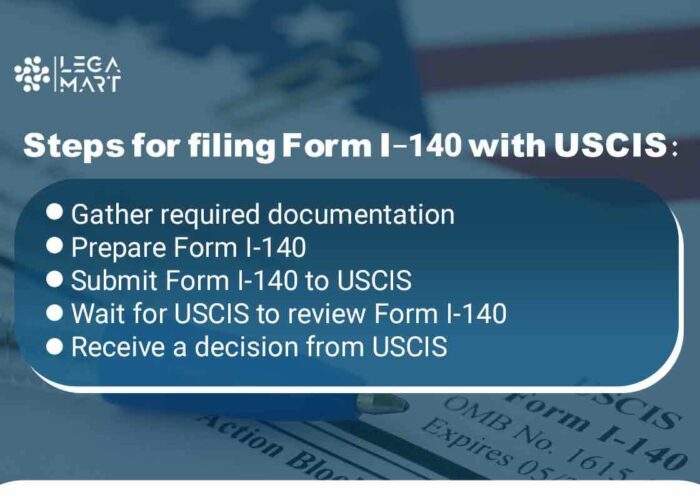
To file the Form I-140 with USCIS, the US employer must follow the steps outlined below:
- Gather required documentation: The US employer must gather all required documentation, including a labor certification from the US Department of Labor, to accompany Form I-140.
- Prepare Form I-140: The US employer must complete Form I-140 and include all required information, including information about the foreign worker and the offered job position.
- Submit Form I-140 to USCIS: The US employer must submit the completed Form I-140 and accompanying documentation to USCIS, along with the required filing fee.
- Wait for USCIS to review Form I-140: USCIS will review Form I-140 and supporting documentation to determine whether the foreign worker is eligible for an immigrant visa or adjustment of status.
- Receive a decision from USCIS: If USCIS approves Form I-140, the foreign worker will be eligible for an immigrant visa or adjustment of status. If USCIS denies Form I-140, the foreign worker will not be eligible for an employment-based immigration visa.
It is important for US employers and foreign workers to carefully follow all steps in the Form I-140 process, as any errors or omissions may result in a denial of the petition.
Priority date
Overview of the Priority Date
The priority date is when a US employer filed Form I-140, Immigrant Petition for Alien Worker, on behalf of a foreign worker seeking permanent residency in the United States through an employment-based immigration visa. The priority date is used by the US Department of State to determine when a foreign worker may be eligible to apply for an immigrant visa or adjustment of status.
Importance of the Priority Date
The priority date is an important aspect of the employment-based immigration process, as it determines when a foreign worker may be eligible to apply for an immigrant visa or adjustment of status.
In general, the priority date is used by the US Department of State to determine the order in which foreign workers will be considered for an immigrant visa or adjustment of status. Foreign workers with an earlier priority date will generally be considered before those with a later priority date.
The priority date also determines when a foreign worker’s spouse and children may be eligible to apply for derivative visas.
It is important for US employers and foreign workers to keep track of their priority date, as it will impact their ability to obtain permanent residency in the United States through an employment-based immigration visa. Any changes in immigration laws or regulations may impact the availability of visas and the priority date.
Form I-485
Overview of the Form I-485
Form I-485, Application to Register Permanent Residence or Adjust Status, is a key document used in the employment-based immigration process in the United States. The form is filed by foreign workers who are already in the United States and wish to apply for permanent residency through an employment-based immigration visa.
The Form I-485 serves as an application for foreign worker to adjust their status from a non-immigrant visa to a permanent residency status.
The form must be accompanied by the required supporting documentation, including a copy of the approved Form I-140, Immigrant Petition for Alien Worker.
Form I-485 is an important step in the employment-based immigration process, as it determines the eligibility of the foreign worker for permanent residency in the United States.
Filing the Form I-485 with USCIS
To file Form I-485 with USCIS, the foreign worker must follow the steps outlined below:
- Gather required documentation: The foreign worker must gather all required documentation, including a copy of the approved Form I-140, to accompany Form I-485.
- Prepare Form I-485: The foreign worker must complete Form I-485 and include all required information, including information about their personal and employment history.
- Submit Form I-485 to USCIS: The foreign worker must submit the completed Form I-485 and accompanying documentation to USCIS, along with the required filing fee.
- Wait for USCIS to review Form I-485: USCIS will review Form I-485 and supporting documentation to determine whether the foreign worker is eligible for permanent residency in the United States.
- Receive a decision from USCIS: If USCIS approves Form I-485, the foreign worker will be granted permanent residency in the United States. If USCIS denies Form I-485, the foreign worker will not be eligible for permanent residency in the United States through an employment-based immigration visa.
It is important for foreign workers to carefully follow all steps in the Form I-485 process, as any errors or omissions may result in a denial of the application. Additionally, the foreign worker must maintain their non-immigrant visa status while Form I-485 is pending with USCIS.
Types of Employment-Based Immigration Visas
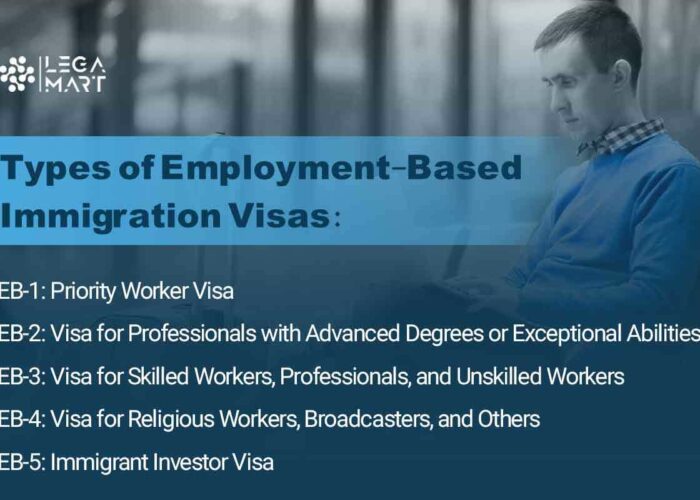
EB-1: Priority Worker Visa
The EB-1 visa, also known as the Priority Worker visa, is for foreign workers with extraordinary abilities in the arts, sciences, education, business, or athletics. To qualify for the EB-1 visa, the foreign worker must demonstrate that they have a sustained record of exceptional achievement in their field and that they are a very small percentage of individuals who have risen to the top of their field.
Who Can Apply for the EB1 Visa?
The EB1 visa is divided into three sub-categories based on different achievements that people can have:
An EB-1A green card, categorized by extraordinary ability.
People with extraordinary arts, science, education, athletics, and business abilities. These individuals must have extensive and/or internationally recognized achievements and are not required to have an employment offer to apply for the EB1 visa.
An EB-1B green card, categorized by outstanding professors and researchers.
Outstanding professors and researchers who have gained international recognition for their contributions in their fields. These individuals must have at least 3 years of experience in research or teaching. In addition, they must demonstrate that they are coming to the US to continue advancing their field in research or teaching positions at a university.
EB-1C green card, categorized for certain Multinational managers or executives.
Multinational managers or executives who have worked for an international branch of a US company for a minimum of 1 year in the past 3 years. They must apply for the EB1 visa to continue working for the same company, and their position in the US must match or be higher than the one they held in a foreign country.
EB-2: Visa for Professionals with Advanced Degrees or Exceptional Abilities
The EB-2 visa is for foreign workers who have advanced degrees or exceptional abilities in the arts, sciences, or business. To qualify for the EB-2 visa, the foreign worker must have a minimum of a master’s or bachelor’s degree and five years of experience in their field. They must also demonstrate that they have exceptional abilities in their field, as determined by an approved labor certification.
EB-2 Eligibility
To secure an EB-2 visa, the applicant must meet specific qualifications. Initially, the applicant must secure sponsorship from an employer who will then be required to obtain a PERM certification unless a National Interest Waiver has already been granted.
The EB-2 visa classifies non-U.S. citizen applicants into one of three categories; each of these categories has distinct requirements, which include; –
- Advanced Degree: Under this category, the applicant must possess an advanced degree or its foreign equivalent. Alternatively, they can demonstrate a bachelor’s degree and five years of “progressive work experience.” The applicant must also satisfy any other requirements listed on the PERM certification.
- Exceptional Ability: This category requires the applicant to prove that they possess expertise “significantly above that ordinarily encountered in the sciences, arts, or business.” In addition, the applicant must meet all requirements specified on the initial labour certification.
- National Interest Waiver: Here, the applicant can submit their petition without a sponsor or labour certification. To qualify, the applicant must possess an advanced degree or exceptional ability, as defined above. They must also prove that waiving the labour certification would benefit the United States and that their proposal is of “substantial merit and national importance.” Lastly, the applicant must show that they can execute their proposal.
EB-3: Visa for Skilled Workers, Professionals, and Unskilled Workers
The EB-3 visa is for foreign workers who are skilled workers, professionals, or unskilled workers. To qualify for the EB-3 visa, the foreign worker must have a minimum of a bachelor’s degree or a combination of education and experience, and the employer must obtain an approved labor certification.
Eligibility Criteria for EB-3 Visa
Skilled Workers
To be eligible as a skilled worker, you must show; –
- That you have a minimum of two years of job experience, education, or training that matches the job requirements stated on the labour certification.
- Relevant post-secondary education can count as training.
- That you are working in a position for which there are no available qualified workers in the United States.
- Professionals
To be eligible as a professional, you must
- Have a US or foreign equivalent baccalaureate degree as the usual requirement for your profession.
- Show that you are performing work that cannot be filled by qualified US workers,
- Neither education nor experience can replace the need for a baccalaureate degree. Other requirements specified on the labour certification must also be met.
- Unskilled Workers
To be eligible for an unskilled worker, you must
- Show that you can perform unskilled labour that requires less than two years of training or experience and is not temporary or seasonal.
- Demonstrate that there are no qualified workers available in the United States.
- Meet any other requirements outlined in the labour certification.
EB-4: Visa for Religious Workers, Broadcasters, and Others
The EB-4 visa is for foreign workers in special categories, including religious workers, broadcasters, and others. To qualify for the EB-4 visa, the foreign worker must meet the specific requirements of their category, and the employer must obtain an approved labor certification.
Eligibility for the EB-4 visa
To be eligible; –
- Applicants must Possess a valid and permanent job offer from a US employer that is not seasonal or part-time.
- The job must be within the applicant’s occupation, and offers from employers outside their expertise will not qualify.
- US employers must demonstrate financial stability to hire foreign workers.
Failure to meet these criteria will render the employer ineligible to apply for the EB-4 visa or hire EB-4 visa applicants.
EB-5: Immigrant Investor Visa
The EB-5 visa is for foreign investors who invest in a new commercial enterprise in the United States. To qualify for the EB-5 visa, the foreign investor must invest a minimum of $1 million, or $500,000, in a targeted employment area and create or preserve 10 full-time jobs for US workers. The investment must also be in a new commercial enterprise, defined as a for-profit activity established after November 29, 1990.
EB-5 Eligibility
To obtain an EB-5 visa, there are two fundamental requirements that must be fulfilled by the applicant:
Investing in a US business
Here, the applicant must invest in a company established after November 29, 1990. If the business was created before or on that date, it must either undergo a significant restructuring or purchase, making it essentially a new enterprise. Alternatively, the investment must lead to a 40% expansion of the company’s overall value or the number of employees.
Intend to create or retain a minimum of 10 full-time job opportunities that US workers can fill.
If the business is situated in a regional centre promoting economic growth, the investment must lead to direct job creation (wherein the business functions as the employer) or indirect job creation (wherein the job opportunities arise as a consequence of the business’s activities). However, if the commercial enterprise is located outside a regional centre, it must generate 10 new positions directly.
Benefits of the investor Green Card or EB-5 visa
The EB-5 visa offers several significant advantages compared to other work visas, including:
- Higher education diplomas or exceptional skills are not mandatory.
- Labor Certification is not necessary
- No American employer sponsorship is required for applicants.
- There are no long waiting times or quota rules, unlike other immigration categories.
- Spouses and children under 21 will obtain a Green Card with the applicant.
- After being a Green Card holder for five years, permanent residency in the US can be acquired.
Summary of Key Points
- Employment-based immigration visas to the USA are divided into five categories: EB-1, EB-2, EB-3, EB-4, and EB-5.
- Each category has specific eligibility requirements, such as the type of job, level of education and experience, and investment amount.
- The processing time for an employment-based visa can vary depending on the demand and the category.
- Employers are required to file a Labor Certification Application (LCA) with the Department of Labor and then an I-140 Immigrant Petition for Alien Worker with the US Citizenship and Immigration Services (USCIS).
- Once the I-140 is approved, the next step is for the foreign worker to apply for an adjustment of status or consular processing, depending on their immigration status in the USA.
Tips for preparing a strong visa application and supporting documents
- Review the requirements: Before beginning the application, make sure to review the requirements for the specific visa applicants are applying for. This will ensure you have all the necessary documents and information ready.
- Be organized: Keep all your documents organized and in one place. This will make it easier to find what needs when filling out the application and submitting supporting documents.
- Be thorough: Make sure to fill out the application completely and accurately. If any questions or fields are left blank, this can delay the processing of the application or even result in a denial.
- Provide supporting documents: Supporting documents can help to strengthen the application. These may include bank statements, proof of employment, or letters of recommendation. Ensure these documents are current, complete, and relevant to the visa application.
- Provide clear and concise explanations: If the applicant has any gaps in the employment history, has travelled extensively, or has any other circumstances that may require an explanation, make sure to provide clear and concise explanations in the application and supporting documents.
- Follow instructions: Follow all instructions carefully, including those for submitting supporting documents. Failure to do so can result in a delay or denial of the application.
Final Thoughts and Recommendations
It is important for potential visa applicants to understand the eligibility requirements for each employment-based visa category and choose the one that best fits their qualifications and circumstances.
Employers should ensure that they are knowledgeable about the LCA and I-140 filing process and comply with the requirements and deadlines set by the USCIS.
Both employers and foreign workers should be aware of the processing times and plan accordingly to avoid delays.
It is advisable to seek the assistance of a qualified immigration attorney to navigate the complex US immigration laws and procedures.
Finally, it is important to be aware of any changes or updates to the US immigration laws and regulations, as these can affect the eligibility and processing of employment-based visas.
Frequently Asked Questions (FAQs)
How long does it take to obtain an employment-based immigrant visa?
The processing time for an employment-based immigrant visa can vary depending on the category and the backlog of visa applications. Typically, it can take several months to several years for the entire process to be completed. Some categories, such as EB-1, have shorter wait times than others, such as EB-3.
Can family members accompany the visa holder to the US?
Yes, spouses and unmarried children under 21 can accompany the visa holder to the US. They may also be eligible to apply for their own employment authorization documents and work in the US.
Can an employment-based immigrant visa holder change employers?
An employment-based immigrant visa holder can change employers, but they must go through the process of obtaining a new visa through the new employer. The new employer must also file a new petition with the USCIS.
Part 2: Complete guide on Employment-based immigration visas to the UK
The United Kingdom (UK) offers a variety of employment-based immigration visas for foreign workers who wish to work in the country. These visas allow foreign workers to enter and work in the UK for a specified time and in some cases, the option to settle permanently.
The UK’s employment-based immigration visas are divided into five tiers, each with its eligibility criteria and requirements. These tiers are:
- Tier 1: This tier is for highly skilled workers and entrepreneurs.
- Tier 2: This tier is for skilled workers with a job offer and a certificate of sponsorship from a licensed UK employer.
- Tier 3: This tier is not currently in use.
- Tier 4: This tier is for students who have been offered a place on a course at a UK educational institution.
- Tier 5: This tier is for temporary workers, including those participating in exchange programs, charity work, or performing arts.
The UK government sets annual quotas for the number of visas issued under each tier, and the eligibility criteria and requirements for each tier are subject to change. Therefore, it is important to regularly check the UK government’s official website for the latest information and guidance on employment-based immigration visas to the UK.
Job Offer from a UK Employer
- The first requirement for obtaining an employment-based immigration visa to the UK is a job offer from a UK employer.
- The job offer must be genuine and should meet the UK’s employment standards, such as minimum wage requirements and working conditions.
- The job should also be one that cannot be filled by a settled worker in the UK, meaning it should be advertised to the local labor market before it can be offered to a non-European Economic Area (EEA) national.
- The UK employer must hold a valid sponsor license, which allows them to sponsor foreign workers for employment-based visas.
Visa-specific requirements
- The type of visa required will depend on the specific job offer, the foreign worker’s qualifications, and the length of the intended stay in the UK.
- For example, the Tier 2 (General) visa is for skilled workers with a job offer and a certificate of sponsorship from a licensed employer.
- The Tier 5 (Temporary Worker) visa is for workers coming to the UK for a specific purpose, such as charity work or performing arts.
- Each tier has eligibility criteria, such as the minimum salary, language requirements, and maintenance funds.
- The foreign worker must also meet the UK’s immigration rules, such as the genuineness test, which assesses the authenticity of the job offer and the foreign worker’s intentions to take the job.
Note: The UK’s immigration rules and policies are subject to change, and it is important to check for the latest information and guidance from the UK government’s official website.
Tier 1 visas
Overview of Tier 1 Visas
The Tier 1 visas are for highly skilled individuals who wish to work and live in the UK. These visas are designed for individuals with exceptional talents, entrepreneurial skills, or significant investments to bring to the UK.
A. Tier 1 (Entrepreneur) Visa
The Tier 1 (Entrepreneur) visa is for individuals with credible and innovative business ideas and the funds to establish and run a business in the UK. To be eligible for this visa, the individual must:
- They have access to at least £50,000 in investment funds or £200,000 if they seek to set up a business in a high-growth sector.
- Provide a credible and innovative business plan.
- They have the skills and experience to establish and run a successful business in the UK.
B. Tier 1 (Investor) Visa
The Tier 1 (Investor) visa allows individuals with substantial funds to invest in the UK. To be eligible for this visa, the individual must:
- Prove that they have access to at least £2 million in investment funds.
- Provide evidence of the source of their funds.
- Invest their funds into approved UK investments, such as UK government bonds or shares in UK companies.
C. Tier 1 (Exceptional Talent) Visa
The Tier 1 (Exceptional Talent) visa is for individuals with exceptional talent in science, humanities, engineering, medicine, digital technology, or the arts. To be eligible for this visa, the individual must:
- Be endorsed by a designated endorsing body, such as Tech Nation for digital technology or the Royal Society for science.
- Prove that they have exceptional talent in their field and that their work has been recognized internationally.
- Provide evidence of their achievements and contributions to their field.
Tier 2 Visas
The Tier 2 visas are for skilled workers with a job offer from a UK employer who holds a valid sponsor license. These visas allow foreign workers to come to the UK and work in a skilled job for a specified period of time.
Tier 2 (General) Visa
The Tier 2 (General) visa is for skilled workers who have a job offer from a UK employer in a role that cannot be filled by a settled worker. To be eligible for this visa, the individual must:
- Have a job offer from a UK employer with a valid sponsor license.
- Hold a certificate of sponsorship from the UK employer.
- Prove that they meet the minimum salary requirements for the role they have been offered.
- Pass the Points-Based System (PBS) test, which assesses factors such as qualifications, age, and work experience.
Exceptions to the salary requirement for UK Skilled Worker visa
There are exceptions to the salary requirement for a UK Skilled Worker visa. If an applicant’s salary will be at least £20,480 per year and at the going rate for the specific occupation, they may still be eligible for the visa even if they do not meet the usual salary requirements and do not work in healthcare or education.
Additionally, certain tradeable points options can reduce the minimum salary threshold to as low as £20,480. Furthermore, an applicant might still be able to apply for a Skilled Worker visa if their job is eligible but their salary is less than the minimum requirement. It’s important to note that the specific eligibility criteria for different types of visas may vary, and applicants should check the requirements for their specific visa type.
Tier 2 (Intra-Company Transfer) Visa
The Tier 2 (Intra-Company Transfer) visa is for employees of multinational companies who are being transferred to a UK branch of their company. To be eligible for this visa, the individual must:
- Have a job offer from a UK branch of their company.
- Hold a certificate of sponsorship from the UK branch.
- Prove that they meet the minimum salary requirements for the role they have been offered.
- Have worked for their company for at least 12 months.
Points-Based System (PBS)
Overview of the PBS
The Points-Based System (PBS) is a system used by the UK government to assess and manage applications for immigration visas to the UK. It operates on a points-based system, where applicants must score enough points to be eligible for a visa. The PBS is used to assess applicants for Tier 1 and Tier 2 visas, among others.
How does the Point-based system work?
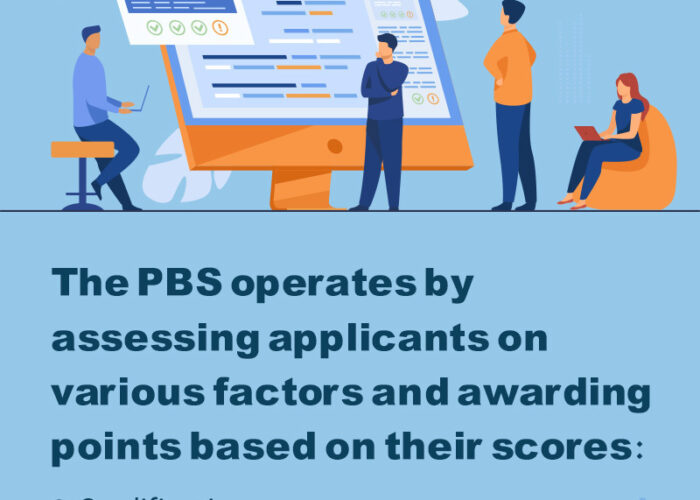
The PBS operates by assessing applicants on various factors and awarding points based on their scores. The factors assessed include:
- Qualifications: Applicants can earn points for their qualifications, such as degrees or professional qualifications.
- Age: Younger applicants are generally favored over older applicants and can earn more points.
- Work experience: Applicants can earn points for relevant work experience.
- English language ability: Applicants must prove that they have good English language ability and can earn points for their test results.
- Sponsorship: Applicants can earn points for having a valid certificate of sponsorship from a UK employer.
Once the applicant has earned enough points, they may be eligible for a visa. However, the number of points required may vary depending on the specific visa category.
Application Process
Overview of the Application Process
The application process for a UK visa is as follows:
- Check if you are eligible for the visa category you are interested in.
- Obtain a certificate of sponsorship from a UK employer (if applicable).
- Complete the online visa application form.
- Pay the visa application fee.
- Attend a biometric appointment to provide your fingerprints and a digital photo.
- Submit your supporting documents.
- Wait for a decision on your visa application.
Required Documentation
The following documents are typically required for a UK visa application:
- A valid passport or travel document.
- A certificate of sponsorship (if applicable).
- Proof of qualifications, such as degrees or professional certificates.
- Proof of English language ability, such as an IELTS test certificate.
- Proof of financial support, such as bank statements or a letter from an employer.
- Proof of work experience, such as a CV or references from previous employers.
Application Fees
The visa application fee for a UK visa varies depending on the visa category and length of stay. The fee is usually paid when submitting the online visa application form and is non-refundable, even if the visa is refused.
Obtain a Certificate of Sponsorship (CoS) from your sponsoring employer for employment-based immigration visas to the UK
- If an applicant is planning on working in the UK through an employment-based immigration visa, it’s crucial to obtain a Certificate of Sponsorship (CoS) from the sponsoring employer. This document confirms the employer’s sponsorship of the applicant’s visa application and allows the same to apply for a work visa.
- To obtain a CoS, the applicant needs to take several steps. The first is finding an employer who is willing to sponsor the applicant. It’s essential to ensure that the concerned employer has a valid sponsor license and is licensed by the UK government to sponsor visa applications. The applicant can find a list of licensed sponsors on the UK government’s website.
- Once the applicant found a sponsor, the employer will need to issue the applicant a CoS. To do this, they’ll need to provide the UK government with information about the job the applicant will be doing, salary, and the qualifications. They’ll also need to confirm that they’ve conducted a Resident Labor Market Test (RLMT) to ensure that there are no suitable settled workers for the job.
- Once the concerned employer has issued the CoS, the applicant can apply for a work visa. The applicant will need to include the CoS reference number in your visa application, along with supporting documents such as the passport and evidence of the qualifications and work experience.
- It’s essential to remember that obtaining a CoS does not guarantee that the visa application will be successful. The UK government will still need to assess the application and determine whether you meet the eligibility requirements for the visa.
Summary of Key Points
- The UK has a Points-Based System (PBS) for assessing and managing applications for immigration visas.
- Tier 1 and Tier 2 visas are for skilled workers and those with job offers from UK employers, respectively.
- The visa application process involves completing an online form, paying a fee, attending a biometric appointment, and providing supporting documents.
Final Thoughts and Recommendations
- It is important to carefully research and understand the requirements and eligibility criteria for the specific visa category you are interested in.
- Make sure to have all required documents ready, including proof of qualifications, English language ability, financial support, and work experience.
- Check the latest information and guidance on the UK government’s official website, as the immigration rules and policies are subject to change.
- Consider consulting with a qualified immigration lawyer or professional for guidance on the visa application process.

